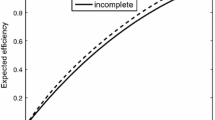Abstract
This paper studies the effect of constraining interactions within a market. A model is analysed in which boundedly rational agents trade with and gather information from their neighbours within a trade network. It is demonstrated that a trader’s ability to profit and to identify the equilibrium price is positively correlated with its degree of connectivity within the market. Where traders differ in their number of potential trading partners, well-connected traders are found to benefit from aggressive trading behaviour. Where information propagation is constrained by the topology of the trade network, connectedness affects the nature of the strategies employed.
Similar content being viewed by others
References
Axtell R. (2005) The complexity of exchange. Economic Journal 115(504): F193–F210
Barabasi, A.-L., & Albert, R. (1999). Emergence of scaling in random networks. Science, 286, 509.
Bell, A. M. (1998). Bilateral trading on a network: A simulation study. In: Working Notes: Artificial Societies and Computational Markets, Autonomous Agents ’98 Workshop, Minneapolis, St. Paul, pp. 31–36.
Brock W.A., Hommes C.H. (1997) A rational route to randomness. Econometrica 65: 1059–1096
Cliff D. (2003) Explorations in evolutionary design of online auction market mechanism. Journal of Electronic Commerce Research and Application 2(2): 162–175
Cliff, D., & Bruten, J. (1997). Minimal-intelligence agents for bargaining behaviors in market-based environments. Technical Report HPL-97-91, HP Labs.
Epstein, J. M., & Axtell, R. (1996). Growing artificial societies: Social science from the bottom up. Washington, DC: Brookings Institute Press; Cambridge, MA: MIT Press.
Evstigneev I.V., Taksar M. (1994) Stochastic equilibria on graphs, I. Journal of Mathematical Economics 23(5): 401–433
Evstigneev I.V., Taksar M. (1995) Stochastic equilibria on graphs, II. Journal of Mathematical Economics 24(4): 383–406
Evstigneev I.V., Taksar M. (2002) Equilibrium states of random economies with locally interacting agents and solutions to stochastic variational inequalities in \({\langle {L}_{1}, {L}_{\infty} \rangle}\). Annals of Operations Research 114(1–4): 145–165
Falbo P., Grassi R. (2004) Equilibrium prices on a financial graph. Computational Economics 24(2): 117–157
Gode D.K., Sunder S. (1997) What makes markets allocationally efficient? . he Quarterly Journal of Economics 112(2): 603–630
Howitt P., Clower R. (2000) The emergence of economic organization. Journal of Economic Behavior and Organization 41(1): 55–84
Kirman A.P., Vriend N.J. (2001) Evolving market structure: An ACE model of price dispersion and loyalty. Journal of Economic Dynamics and Control 25(3–4): 459–502
Lensberg T., Schenk-Hoppé K.R. (2007) On the evolution of investment strategies and the Kelly rule – a Darwinian approach. Review of Finance 11: 25–50
Lovaglia M.J., Skvoretz J., Willer D., Markovsky B. (1995) Negociated exchange in social networks. Social Forces 74(1): 123–155
Markovsky B., Willer D., Patton T. (1988) Power relations in exchange networks. American Sociological Review 53(2): 220–236
Newman M.E.J. (2003) The structure and function of complex networks. SIAM Review 45(2): 167–256
Noble J., Davy S., Franks D.W. (2004) Effects of the topology of social networks on information transmission. In: Schaal S., Ijspeert A.J., Billard A., Vijayakumar S., Hallam J., Meyer J.-A.(eds) Eighth International Conference on Simulation of Adaptive Behavior. MIT Press, Cambridge, MA, pp 395–404
Papadimitriou C.H. (1994) On the complexity of the parity argument and other inefficient proofs of existence. Journal of Computer and System Sciences 48(3): 498–532
Scarf H.E. (1973) Computation of economic equilibrium. Yale Universiy Press (with T. Hansen), New Haven, CT
Smith V.L. (1962) An experimental study of competitive market behaviour. Journal of Political Economy 70: 111–137
Tassier, T., Menczer, F. (in press). Social network structure, segregation, and equality in a labour market with referral hiring. Journal of Economic Behaviour and Organisation.
Tesfatsion L. (2001) Structure, behavior, and market power in an evolutionary labor market with adaptive search. Journal of Economic Dynamics and Control 25(3–4): 419–457
Vriend, N. J. (2006). ACE models of endogenous interactions. In: L. Tesfatsion & K. L. Judd (Eds.), Handbook of computational economics, Vol. 2, Chap. 21 (pp. 1047–1079). Elsevier.
Watts D., Strogatz S. (1998) Collective dynamics of “small-world” networks. Nature 393: 440–442
Widrow B., Hoff M.E. (1960) Adaptive switching circuits. IRE WESCON Convention Record 4: 96–104
Wilhite A. (2001) Bilateral trade and ‘small-world’ networks. Computational Economics 18: 49–64
Wilhite, A. (2006). Economic activity on fixed networks. In L. Tesfatsion & K. L. Judd (Eds.), Handbook of computational economics, Vol. 2, Chap. 20 (pp. 1013–1045). Elsevier.
Author information
Authors and Affiliations
Corresponding author
Rights and permissions
About this article
Cite this article
Ladley, D., Bullock, S. The Strategic Exploitation of Limited Information and Opportunity in Networked Markets. Comput Econ 32, 295–315 (2008). https://doi.org/10.1007/s10614-008-9140-8
Received:
Accepted:
Published:
Issue Date:
DOI: https://doi.org/10.1007/s10614-008-9140-8




